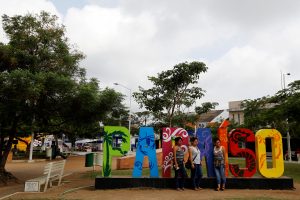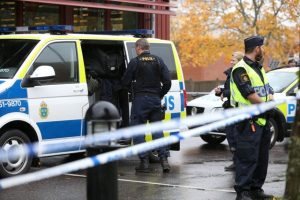
By Gabriel Stargardter
PARAISO, Mexico (Reuters) – Until recently, Edgar Barrera enjoyed a life many Mexicans could only hope for.
In a few short years, the 36-year-old bookkeeper rose from handyman to white-collar worker at what seemed to be one of the most stable companies in Latin America: state-owned oil firm Pemex.
Thanks to Pemex, Barrera met his wife, vacationed on the Mayan Riviera and envisaged a rewarding career without leaving his hometown in Tabasco, a rural state at the southern hook of the Gulf of Mexico where more than half the population lives on less than roughly $92 a month.
Then everything changed.
Oil prices plummeted, forcing Pemex to cut his and thousands of other jobs across Mexico. An energy reform, meant to spur business with private competitors, struggled to attract immediate investment. And the gang violence that has crippled Mexico over the last decade finally spread to Tabasco, previously a relatively peaceful corner of the country.
Mounting consequences, from an economic recession to soaring murder rates, have rapidly made Tabasco one of Mexico’s most troubled states. Its small, but once seemingly solid, middle-class now struggles with a downturn and lurid violence.
Barrera himself, after brushes with extortionists and kidnappers who may have once been Pemex colleagues, recently sought asylum in Canada.
Paraiso, or “paradise,” is the Tabasco town where Barrera grew up and worked at a Pemex port. It is “now a hell,” he said.

Women take a stand for a photograph with the letters of Paraiso in Paraiso, Tabasco, Mexico April 25, 2018. REUTERS/Carlos Jasso
It’s little surprise that industry turbulence would hurt Tabasco, home to Mexico’s first petroleum discovery and a state where more than half the economy, and nearly half the jobs, rely on the oil sector.
But the extent of the problems has caught locals, industry executives and government officials off guard, especially as criminals increasingly exploit what’s left of any prosperity by targeting Pemex resources, equipment and employees.
“The oil debacle hit us hard,” said Tabasco Governor Arturo Nunez. “It caused social problems that without question are contributing to higher crime.”
President Enrique Pena Nieto, now in his last year in office, made an overhaul of the energy industry his signature initiative, ending Pemex’s longstanding grip on exploration, production, refining and retail fuel sales. Proponents long argued that operators besides Pemex are needed to reverse more than a decade of declining crude output and unlock potential in untapped deposits.
But the reform, finalized in 2014, came into law just as global oil prices collapsed, dampening companies’ willingness to invest. Despite a recent rebound, the price of crude in global markets plummeted by as much as 76 percent as of June of that year.
Since then, Pemex has slashed nearly 18,000 jobs across Mexico, about 13 percent of its workforce, according to company figures. In Tabasco, Pemex let go 1,857 workers, or roughly 12 percent of the 16,000 jobs the state shed between 2014 and 2016, according to government data. Many of the other layoffs were among suppliers and other businesses that rely on Pemex.
Combined, the cutbacks gave Tabasco Mexico’s highest unemployment rate and mired the state in recession. In 2016, the most recent year for which data is available, Tabasco’s economy shrank by 6.3 percent. It is the only state where both poverty and extreme poverty, defined by the government as monthly income of less than about $50, have risen in recent years.
Compounding troubles nationwide, the woes have eroded support ahead of a July 1 presidential election for Pena Nieto’s successor as the candidate of the ruling Institutional Revolutionary Party. Instead, a leftist former Mexico City mayor – and native son of Tabasco – dominates polls. Andres Manuel Lopez Obrador, the 64-year-old frontrunner, promises to build a refinery in his home state.
Although Pemex has recently begun to hire back a few workers, other companies have been reluctant to invest in states like Tabasco, where oil production is now nearly 70 percent below a peak in the early 1990s. With supply abundant worldwide, and an ever-growing flow of crude from U.S. shale, would-be investors are wary of Mexico’s crime, corruption and violence.
“We decided not to start,” said Javier Lopez, a Texas-based attorney who recently scrapped plans to launch a business trucking fuel from the United States into Mexico. “We really were afraid we’d get a truck stolen, a driver killed.”
For more than a decade, Mexico’s government has deployed police, the military and intelligence forces to topple powerful drug kingpins. As they fell, cartels morphed and moved into new rackets, including theft and extortion of businesses in industries from agriculture to mining and oil.
Earlier this year, Reuters reported how fuel thieves are crippling Mexico’s refineries and unleashing bloodshed in formerly calm centers of Pemex operations.
In Tabasco, police registered 388 murders last year, over triple the number in 2012. Despite a population of 2.4 million people, small compared with many of Mexico’s 30 other states and giant capital district, Tabasco had the fourth-highest kidnapping tally and sixth-highest number of extortions reported last year.
Current and former Pemex workers are at both ends of the crimes – some as victims but others as instigators, participants or informants. Emboldened by the impunity and graft that have enabled crime nationwide, some locals have turned to illicit businesses, joining or seeking to start gangs that steal Pemex fuel, machinery and supplies. Others are targeting relatively well-off current and former Pemex workers, such as Barrera.
In a statement, Pemex said it “has zero tolerance with any worker involved in any crime.” The company said it cooperates with local, state and federal police to investigate illegal activity, but declined to comment on specific episodes or cases involving individual workers mentioned in this story.
During a recent interview, Carlos Trevino, Pemex’s chief executive, conceded that employees are increasingly at risk because of their jobs and pay. “Petroleros have a better salary than many other people,” he said, using the Spanish term for oil industry workers.
Across Mexico, Trevino added, the company is increasing measures to ensure the security of personnel and property. It has taken its name and logo off trucks. It told workers to stop wearing Pemex uniforms off site.
Still, he said, “it’s hard to have a completely safe operation.”
“This thing in Tabasco,” he added, “it’s not good.”
CRUDE HISTORY
Mexico’s first known oil discovery took place in Tabasco in 1863. Manuel Gil y Saenz, a priest, was rushing to see his ill mother when his horse’s hoof got stuck in black sludge, according to a local history of the find.
Despite warnings by natives that a witch there turned people into salt, the priest returned and began tapping the oil. With partners, he later sold his venture to a British oil company.
In 1938, Mexico expropriated foreign-owned oil assets and created Petroleos Mexicanos, as Pemex is formally known. Over the following decades, production grew in other regions along the Gulf coast. In 1972 prospectors found a giant deposit known as the Mesozoic Chiapas-Tabasco oilfield, prompting a rush to develop the state.
To handle growing output from Tabasco, Pemex in 1979 began building the Dos Bocas port and terminal in Paraiso, a hot, marshy town of 94,000 people surrounded by cacao and coconut plantations.
For locals, who previously subsisted on small-scale agriculture and fishing, “Pemex came and changed our lives,” said Ricardo Hernandez Daza, head of a local union of roughly 3,000 workers who staff many industry sites.
Barrera, the auditor now seeking asylum, joined Pemex in 2004.
That year, the country’s oil output reached a record high and opportunities seemed boundless. Mexico was one of many producers poised to benefit from steadily climbing prices as the global industry, before the shale boom, faced “peak oil,” the assumption that most of the world’s supply was known and diminishing.
First hired as a maintenance worker, Barrera worked his way up through other positions, got on-the-job training and eventually began reviewing company accounts for a salary of about $2,000 a month. He married a fellow Pemex auditor, bought two cars and enjoyed regular seafood outings with his wife, their daughter and two stepsons.
Until oil prices plunged.
Barrera weathered initial Pemex layoffs, but in November 2015 was let go. He immediately sought other jobs, but with many others already scrambling for work, he found only occasional freelance assignments.
Soon, Paraiso was reeling.
Two brothers, Mario and Pedro Maciel, emerged as local crime bosses, according to state prosecutors. Rumors swirled they had set up a branch of the Jalisco New Generation cartel, known for drug trafficking, fuel theft and countless other crimes across Mexico.
Some Gulf of Mexico oil workers, many of whom come from inland states, were already getting extorted by the cartel on trips into Jalisco New Generation territory.
Alayn Herver, a 28-year-old native of the central state from which the cartel took its name, until last year worked on offshore oil rigs that dot the Tabasco shoreline. Because of the intense schedules required there, Herver would spend two weeks on the rigs and then two weeks on leave back home in Jalisco.
In October 2016, while in a bar in his hometown of Ciudad Guzman, a stranger approached him and demanded roughly $1,000, about half his monthly salary. “We know you earn well,” the man said. “Do you want something to happen to you?”
At first, Herver thought the man was joking. Outside, though, some of the man’s colleagues awaited in an SUV, ready to take him to an ATM. Herver realized they were members of the Jalisco cartel.
He paid the men, who told him a similar payoff would be expected each month. For half a year, Herver complied. The transaction became so routine that the gang members appeared to lose interest.
Herver didn’t report the extortion. Like many Mexicans, he was wary of widespread corruption in police ranks and feared they would only make matters worse.
The following April, he decided to skip a payment.
On his next trip home, in May 2017, local police pulled him over, Herver said. They handcuffed him and put him in their patrol car. “You’ve got yourself into trouble,” he recalled one officer telling him.
Alejandro Romero, a senior officer with the Ciudad Guzman police force, declined to comment on the incident. The Jalisco state attorney general’s office didn’t respond to requests for comment.
As another policeman followed in Herver’s car, a 2007 Mini Cooper, the officers drove to a spot near the city dump, he said. There, six armed men, including the gang member who first approached him, pummeled Herver.
“Pull his pants down,” one of the gangsters said.
They beat his bare buttocks with a paddle and repeatedly threatened to rape him. One of the assailants put a gun to his head, while another grabbed his cell phone and began posting live video to Herver’s own Facebook feed.
Horrified, friends and family watched, the raw footage shifting from Herver’s drained expression to close-ups of his bloody behind.
“I thought they were going to kill me,” Herver said.
Instead, they let him go, keeping the Mini as payment.
“A PIECE OF THE ACTION”
In Paraiso, the Maciel brothers denied connections to the cartel or any such crimes. They published an open letter on Facebook stating they were law-abiding citizens.
“We are a family,” they wrote in the letter, “dedicated to its work for Pemex at Dos Bocas,” the port.
A worker named Pedro Maciel did, in fact, work for Pemex in Tabasco as recently as 2017, according to a database of company workers reviewed by Reuters. Mario’s name didn’t appear in the registry.
For locals, the brothers’ reassurances made little difference.
It was already apparent that a Pemex job wasn’t what it once was. Others besides the Maciel brothers were suspected across Paraiso of using their oil-industry positions as perches from which to steal fuel, extort workers and commit other crimes.
Those familiar with the industry say it makes sense that criminals, not just victims, could emerge from the Pemex payroll. Even if not committing atrocities themselves, some employees are believed to cooperate with gangs for their own cut of the proceeds or, merely, out of fear.
“They know the guts of the place, so they can provide information,” said Raul Munoz, a former Pemex chief executive, who now has private business with the company in Tabasco and says he faces regular security problems. “Everyone wants a piece of the action.”
Barrera, the auditor, and his family soon were swept up in the action. Last October, kidnappers captured a brother-in-law. Days before, after three decades of Pemex service, he had received a retirement bonus of roughly $20,000.
Within days, the family cobbled together a ransom of about $30,000. The kidnappers released him. With contact information stolen from his telephone, though, they began calling friends and family, demanding more.
The brother-in-law declined to speak with Reuters about the kidnapping.
Like Herver, the family opted not to go to the police.
“Pemex’s workforce is contaminated,” Barrera said, echoing family members who believe the kidnapping was planned with inside information. “The workers are feasting on one another.”
Last November, Barrera secured a few weeks’ work as a Pemex contractor. The threats grew closer.
A colleague told Barrera’s wife, who still works at Pemex, that suspicious men had been asking about her outside the office gates. Colleagues then told Barrera that armed men were waiting outside the office for him, too.
Terrified, he slept in the office that night.
Enough, he thought.
Barrera booked a ticket to Canada, where Mexicans can travel with no visa. He landed in Toronto last Christmas and applied for asylum. He hopes to bring his family, who moved to Villahermosa, Tabasco’s capital, in order to avoid the gangsters in Paraiso.
Herver, the rig worker whose beating was streamed live on Facebook, also fled to Canada.
“I was doing well at Pemex,” he said. But after the assault, “my only alternative was to leave.”
He, too, applied for asylum.
A spokeswoman for the Immigration and Refugee Board of Canada declined to comment on either case, citing privacy laws.
On January 31, coordinated shootings erupted overnight across Paraiso.
Among the dead: the Maciel brothers. Local prosecutors said they were killed in a fuel-theft dispute. Their assassins, prosecutors added, died two months later in a shootout with police.
Even what should be legitimate business is getting more violent.
Daza, the local union boss, said his sprawling collective of construction, welding, tubing and other laborers has grown aggressive to protect its share of dwindling oil work. The union is one of many independent labor groups that represent workers and compete with one another for industry jobs.
Among other tactics, he admits to assaulting rival union members to keep them from job sites. They wield baseball bats, not firearms or knives, to avoid felony charges, he said.
When strangers in out-of-state rental cars arrive in Paraiso, the union and others like it send members to their hotel to demand work at whatever project they’re planning. If they don’t deliver, the unions sometimes shut sites down.
The tactics are not out of the ordinary in a country and industry where corrupt labor leaders are known to bribe both companies and members in exchange for keeping positions filled.
But they have also fueled job losses.
Because of the unions’ demands, oil services companies Oro Negro and Constructora y Perforadora Latina left, depriving Paraiso of 300 jobs, according to a local newspaper report. Neither of the companies, based in Mexico City, responded to requests for comment.
Daza said he has little choice but to use force at a time when the oil business is both the root of Paraiso’s problems and its only hope of recovery. “We’re in danger of extinction,” Daza said. “If nobody comes to save us, we’re screwed.”
(Additional reporting by Shadia Nasralla in London. Editing by Paulo Prada.)







